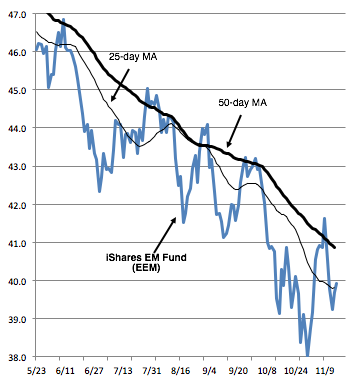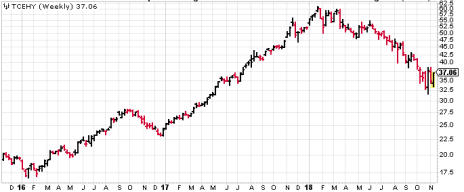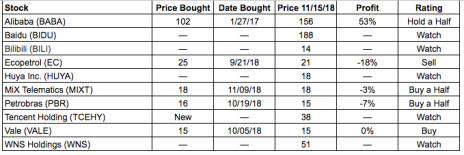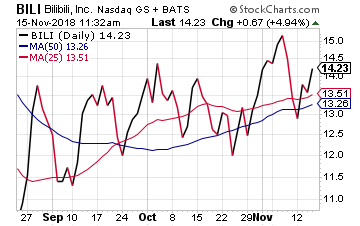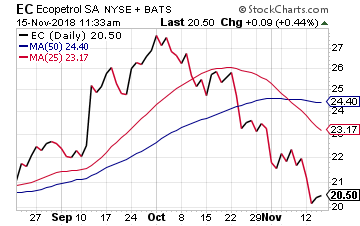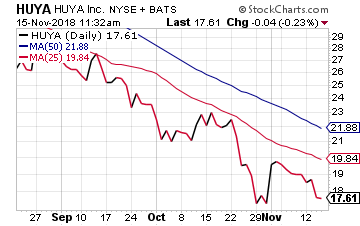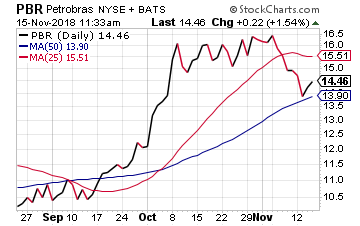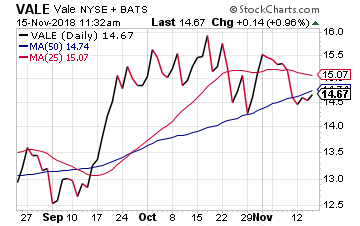There isn’t a ton of good news in this new issue, but there are definite signs that emerging market stocks are making an effort at putting in a bottom. Emerging market stocks (as reflected in the MSCI EM ETF) are above their 25-day moving average and have put a little daylight between themselves and their late-October low. We’re also seeing a few stocks attracting flashes of buying interest, which is also a hopeful sign.
Cabot Emerging Markets Investor 672
[premium_html_toc post_id="164172"]
Cabot Emerging Markets Timer
The Emerging Markets Timer is our disciplined method for staying on the right side of the emerging markets. The Timer is bullish when the index is above the lower of its two moving averages and that moving average is trending up.
Our Emerging Markets Timer remains negative, though the next few sessions will be key to watch. The decent-looking bounce in the iShares EM Fund (EEM) ran into strong resistance near its 50-day line earlier this month. But despite the recent slide, the fund is holding above its October lows and hanging around its lower (25-day) line—a good two or three days from here could produce a green light.
Still, we don’t anticipate signals—right now, the intermediate-term trend remains down, so we continue to advise a defensive posture. But it’s important to keep your eyes open in case the bulls make a stand in the days ahead. We’ll be on the horn if anything changes.
Finding the Patience
It’s one thing to say that the way to get through a nasty stretch in the market is to go to cash and stay there until the market is back on its feet. It’s another thing entirely to be really happy about spending months on the sidelines.
But that’s what has to be done, so that’s what we’re doing.
Emerging market stocks peaked in January and Chinese ADRs peaked in June, and it’s been mostly downhill from there.
Fortunately, we’re seeing signs that selling pressures are easing. The MSCI Emerging Markets ETF (EEM) got a little congested in late October and actually bounced back above its 50-day moving average on November 7. That rally didn’t last, but EEM remains north of its October lows.
Chinese stocks (PGJ) put in the same kind of short bottom in October, the same kind of rally in November and the same kind of pullback that hasn’t taken out its October lows.
We’re also seeing sparks of interest in stocks that we have had in the portfolio in the recent past. GDS Holdings (GDS), for instance, popped a nearly 10% rally on November 13 despite missing earnings estimates with its quarterly report that morning. Investors liked the nearly doubled amount of revenue-generating space at the company’s high-performance data centers in China and the news that nearly 19,000 square meters of new customer commitments were booked during the quarter. GDS has nearly 44,000 square meters under construction, with a pre-commitment rate of 45.5%. GDS has held support at 22, which was the bottom after the stock’s disastrous July free fall. It’s not as good as a wholesale rebound in the Chinese ADR space, but it’s still a positive sign, and the follow-through action on Wednesday strengthened the picture.
Autohome (ATHM) also came in for a buying spike on Tuesday. Autohome reported quarterly results on Monday that beat on both top and bottom lines, but investors still dropped the stock from 67 at the open to 64 at the close. So, Tuesday’s bounce from 67 at the open to above 70 at the close was a very hopeful piece of work.
All the earnings-fueled advances in the world will have a hard time overcoming the general antipathy toward risky sectors like emerging markets in general and China in particular. But dams leak before they burst, and little pops of bargain hunting for out-of-favor issues is often the first sign.
There are a few other stocks making uncharacteristically strong moves, including Beigene (BGNE) and YY Inc. (YY). The big gains by BGNE and YY, while good to see, don’t send as strong a signal as GDS and ATHM, because the stocks haven’t made as much progress against their October–November low ranges.
To return to the original thesis, which is that being in cash isn’t as much fun as owning a group of stocks that are stampeding higher, there’s one addendum, which is personal.
It’s this: While sunny days are far nicer, there is a particular satisfaction in going out on a rainy day with a raincoat, an umbrella and wellies, especially if one of your friends is getting soaked to the skin and has hair plastered down over his forehead. It may be mean, but it’s also human nature. So, go ahead and enjoy it if one of your friends complains about emerging market losses. You know better, that preserving capital today will lead to larger gains once the bulls return.
There’s one recent news story that is both cautionary and optimistic. Official figures released by China on Wednesday showed retail sales softening in October, which isn’t good for the Chinese e-commerce companies we follow. But Chinese figures also show that industrial output and fixed-asset investment are picking up, indicating that the government’s stimulus efforts are doing their job.
Featured Stock
What’s a Dime Worth?
Tencent Holdings (TCEHY)
Among the Chinese ADRs enjoying bounces in the past couple of days, Tencent Holdings is probably the best known. Tencent is the “T” in the BAT stocks (Baidu, Alibaba and Tencent), the leaders of the Chinese internet world, which is the equivalent of the FANG stocks (Facebook, Amazon, Netflix and Google) in the U.S.
Tencent’s biggest draw is its WeChat messaging system, which provides voice, video and texting to its base of over one billion users (that includes the domestic Chinese users, whose version is called Weixin). Over the years, WeChat/Weixin has expanded to include shopping, payments, social media and ride-hailing services.
The company is a real giant, with a market cap of $348 billion and annual sales of around $45 billion. Revenue comes about three-quarters from value-added services (mostly games, but also payments, streaming video and live broadcasts), with advertising making up most of the rest. There’s a self-perpetuating dynamic at work here, as WeChat’s popularity and value-added services encourage people to join—and the more people who join, the more data is harvested, which raises the value of targeted advertising.
Tencent reported its Q3 results on Wednesday (November 14) and the results were both encouraging and discouraging. Revenue was up 19% over Q3 2017, mostly from growth in payment-related services, advertising, content sales and cloud services. A revenue gain of 19% would be great for most companies, but for Tencent, it’s the slowest growth since Q2 2015. Earnings per share were up 11% and the company’s after-tax profit margin was 24.4%.
While Tencent’s Q3 numbers beat expectations, they also reflected the major obstacle faced by its lucrative game operations, which is the Chinese government’s current crackdown on online games, primarily through a freeze on new game approvals. (While the company has a sizable pipeline of previously approved games, it hasn’t been able to capitalize on the global popularity of Fortnite and PlayerUnknown Battlegrounds.) The government has always worried about game addiction (or just time wasting), and these waves of restriction have come and gone several times over the last decade. Tencent has a statement in its Q3 report about “seeking to create a healthy game environment for children,” leading management to implement “stringent, self-imposed limitations of game playing by minors,” including real-ID verification and face recognition checks. Chinese companies that are being hammered by government regulation usually refer to their “stringent self-imposed limitations.”
Tencent has been able to soften the harm from game restrictions with increases in advertising and other services, but the damage is real. It’s a measure of Tencent’s strength that it has done as well as it has.
The Q3 report also revealed free cash flow of about $3.8 billion (give or take, depending on the yuan’s movements), which is another reason to like Tencent. The amount of cash the company has to work with has enabled it to take equity interests in Tesla, Activision Blizzard and Snap and form joint ventures with Changan Auto (for self-driving technology), Samsung (for AI powered devices) and others.
So, with all these strengths, why has TCEHY been in a downtrend since January, falling from 61 then to the mid-30s in recent trading? Part of the problem can be seen by comparing the charts of TCEHY and the iShares EM ETF (EEM) that forms the basis for the Cabot Emerging Markets Timer. TCEHY and EEM peaked at the same time in January and hit their bottom in late October. EEM fell by 27%, top to bottom, and TCEHY, being a Chinese tech stock and having the government around its neck, fell 47%. That’s part of the story.
The other part of the story is that TCEHY doesn’t have a full exchange listing in the U.S. It trades over-the-counter, which is a big reason it has only 210 institutional sponsors. Most mutual funds can’t own an OTC stock.
The big decline in TCEHY may be a major asset when (and if) we get a couple of things happening. The first would be a revival of investors’ appetite for big, profitable Chinese tech stocks, with the second being a green light for emerging market stocks as a whole. TCEHY trades at a reasonable 30 P/E and has rebounded to the mid-30s on the good earnings news. It will be a great addition to our watch list—the odds are high that shares can make a solid run once the bulls retake control of the market. WATCH.
Tencent Holdings (TCEHY)
Tencent Building
Hi-tech Park
Kejizhongyi Avenue
Shenzhen 518057 China
www.tencent.com
Model Portfolio
Invested 25% Cash 75%
Updates
We’re not going to say emerging market stocks are showing any real strength, but there are a few encouraging signs out there—the iShares EM Fund (EEM) has stopped underperforming U.S. markets during the past couple of months, and even during the selloff of the past week, it’s held above its October low. Many individual stocks are showing similar patterns.
The next few days should be telling—we’re keeping our eyes open, as two or three solid up days from here could produce a new buy signal. If that happens, we won’t be diving in head first, but will begin to slowly extend our line, and if we develop profits, put more money to work.
But that’s down the road. We always invest based on the evidence in front of us, and right now, while there are encouraging signs, the intermediate-term trend is still pointed down for most emerging market stocks, so we’re sticking with a defensive posture. Indeed, tonight we’re letting go of our half position in EC, which has been caught up in the oil stock meltdown.
Alibaba (BABA) is showing some of the encouraging signs we’re also seeing with the general EM universe. Except for one day in late October when the market was imploding, BABA has held above its low of 135 from October 11, it’s shown some decent accumulation this month and has lifted above its 50-day line for the first time since June! Earnings estimates have been trimmed since the quarterly report, but Wall Street is thinking growth should pick up soon—for the fiscal year that starts next April, analysts see Alibaba’s top and bottom lines growing 37% and 30%, respectively. If that growth occurs, we think there’s a great chance BABA will enjoy a nice rally down the road. Continue to hold your half position. HOLD A HALF.
Baidu (BIDU), on the other hand, isn’t looking as hot—shares plunged to a low of 178 in October and, after a quick bounce earlier this month, are nearly back to that low. Plus, whereas there’s optimism that BABA’s investment spree may ease a bit going forward, analysts aren’t as sanguine about BIDU (2019 estimates see revenue up 17% and earnings up just 12%). We’ll keep it on the watch list a bit longer, but if BIDU can’t show some relative strength soon, the odds are decreased that it will regain its glory during the next upturn. WATCH.
Bilibili (BILI) has pulled back after testing resistance around 15, with the sloppy market of the past week not helping, either. Still, BILI remains in good shape, generally building a solid base in the 12 to 15 area for the past couple of months. The big tell should come next week (November 20) when earnings are announced—analysts see revenues of $147 million and a loss of seven cents per share, but as always, the stock’s reaction will be what counts most.WATCH.
Ecopetrol (EC) held up very well when oil prices initially started to skid, but the mini-crash in that commodity (and meltdown in all energy stocks) has been too much for the stock to resist—shares have been under strong distribution and dipped below their 200-day line this week. EC could bounce, but the strong downtrend and break of support tells us it’s not likely to be a leader. We’ll cut loose our half position tonight. SELL.
Huya Inc. (HUYA) continues to act poorly, but we have to say, the fundamentals here remain enticing—the company’s quarterly report this week was a good one, with local currency revenues up 119%, earnings of five cents topping estimates by a penny (and up from a loss a year ago) and most sub-metrics (mobile monthly average users up 28%, total paying users up 38%) looking good, too. The outlook was fine (nearly 100% expected revenue growth), and the stock initially popped on the news before falling back. Our patience here isn’t unlimited, but we’re fine keeping HUYA on the watch list to see if it can get its mojo back during the next market uptrend. WATCH.
MiX Telematics (MIXT) acts great, holding the vast majority of its gains from its post-earnings surge two weeks ago. We think many earnings winners from this cycle will be leaders down the road, and MIXT fills the bill. While the firm doesn’t offer the fastest growth (10% to 15% top line, 15% to 20% bottom line), we think big investors will be attracted to the relative stability of the business and the solid growth potential. We’re OK buying a half position here or on further dips. BUY A HALF.
Petrobras (PBR) has been dented by the decline in oil prices, but it’s holding up much better than EC—shares dipped to their rising 50-day line and have held that support so far. Of course, there’s a lot more to PBR’s story than just energy prices; the firm’s disposition of assets and debt paydown are helping drive improved perception. Indeed, Brazil’s Senate has fast tracked a bill that would allow Petrbroas to auction off some offshore oil assets that some think could net the company nearly $8 billion! Analysts still see the firm’s bottom line rising to north of $2 per share next year. If you don’t own any, you can buy a little on this dip. BUY A HALF.
Vale (VALE) has been all over the place since the start of October, but net-net it hasn’t made much progress either way, basically chopping between 14 and 16. Earnings are expected to rise nearly 30% next year as demand for the firm’s high-grade iron ore picks up. We’ll stay on Buy, though a drop below 13.5 would be a red flag. BUY.
WNS Holdings (WNS) is a mere 8% off its high, miles better than just about any emerging market stock. Obviously, part of that is the firm’s steady outlook—earnings are likely to ramp in the high single digits/low double digits range going forward, and demand for its outsourcing services are a great bet to gradually improve. WNS looks like a good get-your-foot-in-the-door stock once the market improves. WATCH.
[premium_html_footer]
Send questions or comments to paul@cabotwealth.com.
Cabot Emerging Markets Investor • 176 North Street, Salem, MA 01970 • www.cabotwealth.com
All Cabot Emerging Markets Investor buy and sell recommendations are made in issues or updates and posted on the Cabot subscribers’ website. Sell recommendations may also be sent to subscribers as special alerts via email. To calculate the performance of the hypothetical portfolio, Cabot “buys” and “sells” at the midpoint of the high and low prices of the stock on the day following the recommendation. Cabot’s policy is to sell any stock that shows a loss of 20% in a bull market (15% in a bear market) from our original buy price, calculated using the current closing (not intra-day) price. Subscribers should apply loss limits based on their own personal purchase prices.
THE NEXT CABOT EMERGING MARKETS INVESTOR ISSUE IS SCHEDULED FOR November 29, 2018
We appreciate your feedback on this issue. Follow the link below to complete our subscriber satisfaction survey: Go to: www.surveymonkey.com/chinasurvey
Cabot Emerging Markets Investor is published by Cabot Wealth Network, an independent publisher of investment advice since 1970. Neither Cabot Wealth Network, nor our employees, are compensated in any way by the companies whose stocks we recommend. Sources of information are believed to be reliable, but they are in no way guaranteed to be complete or without error. Recommendations, opinions or suggestions are given with the understanding that subscribers acting on information assume all risks involved. © Cabot Wealth Network 2018. Copying and/or electronic transmission of this report is a violation of the copyright law. For the protection of our subscribers, if copyright laws are violated, the subscription will be terminated. To subscribe or for information on our privacy policy, visit www.cabotwealth.com, write to support@cabotwealth.com or call 978-745-5532.
[/premium_html_footer]



